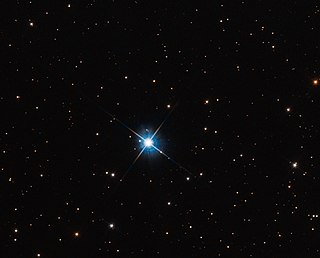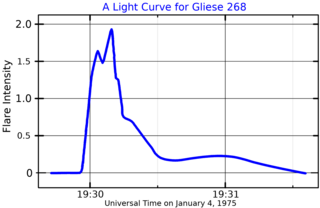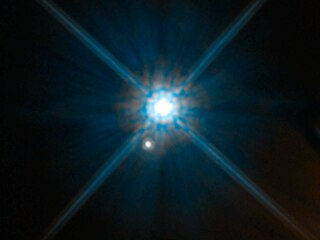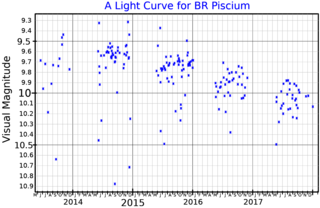Gliese 65, also known as Luyten 726-8, is a binary star system that is one of Earth's nearest neighbors, at 8.8 light-years from Earth in the constellation Cetus. The two component stars are both flare stars with the variable star designations BL Ceti and UV Ceti.
HD 101930, also known as Gliese 3683, is an orange hued star with an orbiting exoplanet located in the southern constellation Centaurus. It has an apparent magnitude of 8.21, making it faintly visible in binoculars but not to the naked eye. The system is located relatively close at a distance of 98 light years but is receding with a heliocentric radial velocity of 18.4 km/s. It has a relatively large proper motion, traversing the celestial sphere with an angular velocity of 0.320″·yr−1.
HD 114729 is a Sun-like star with an orbiting exoplanet in the southern constellation of Centaurus. Based on parallax measurements, it is located at a distance of 124 light years from the Sun. It is near the lower limit of visibility to the naked eye, having an apparent visual magnitude of 6.68 The system is drifting further away with a heliocentric radial velocity of 26.3 km/s. The system has a relatively high proper motion, traversing the celestial sphere at an angular rate of 0.373″·yr−1.
Gliese 1 is a red dwarf in the constellation Sculptor, which is found in the southern celestial hemisphere. It is one of the closest stars to the Sun, at a distance of 14.2 light years. Because of its proximity to the Earth it is a frequent object of study and much is known about its physical properties and composition. However, with an apparent magnitude of about 8.6 it is too faint to be seen with the naked eye.

Gliese 440, also known as LP 145-141 or LAWD 37, is an isolated white dwarf located 15.1 light-years from the Solar System in the constellation Musca. It is the fourth closest known white dwarf to the Sun
HD 45652 is a star with an exoplanetary companion in the equatorial constellation of Monoceros. It was officially named Lusitânia on 17 December 2019, after the IAU100 press conference in Paris by the IAU. This star has an apparent visual magnitude of 8.10, making it an 8th magnitude star that is too dim to be visible to the naked eye. The system is located at a distance of 114 light-years from the Sun based on parallax measurements, but is drifting closer with a radial velocity of −5 km/s. It shows a high proper motion, traversing the celestial sphere at an angular rate of 0.188 arcsec yr−1.
HD 181433 is a star with a system of orbiting exoplanets located in the southern constellation of Pavo. With an apparent visual magnitude of 8.40, it is too faint to be visible to the naked eye. It lies at a distance of 88 light years from the Sun based on parallax measurements, and is drifting further away with a radial velocity of +40 km/s. The system shows a high proper motion, traversing the celestial sphere at an angular rate of 0.340 arcsec yr−1.
HIP 5158 is a star with a pair of orbiting substellar companions, located in the equatorial constellation of Cetus, the whale. It has the older designation CD-23 395, which is derived from the Cordoba Durchmusterung catalogue of southern stars. Based on parallax measurements, it is located 169 light years from the Sun. It has an absolute magnitude of 7.11, but at that distance the star has an apparent visual magnitude of 10.16, which is too dim to be visible to the naked eye. The system is receding with a radial velocity of 15.3 km/s, and it has a relatively high proper motion, traversing the celestial sphere at an angular rate of 0.205″·yr−1.

Gliese 268 is a RS Canum Venaticorum variable star in the Auriga constellation. RS CVn variables are binary star systems with a strong magnetic field influenced by each star's rotation, which is accelerated by the tidal effects of the other star in the system. Gliese 268 in particular is composed of a binary system of two M-type dwarfs, or red dwarfs, and is one of the one hundred closest star systems to the Earth. The primary component of the system has an apparent magnitude of 12.05, and the secondary component an apparent magnitude of 12.45. Neither is visible to the naked eye from Earth.

Stein 2051 is a nearby binary star system, containing a red dwarf and a degenerate star, located in constellation Camelopardalis at about 18 ly from Earth.
Gliese 163 is a faint red dwarf star with multiple exoplanetary companions in the southern constellation of Dorado. Other stellar catalog names for it include HIP 19394 and LHS 188. It is too faint to be visible to the naked eye, having an apparent visual magnitude of 11.79 and an absolute magnitude of 10.91. This system is located at a distance of 49.4 light-years from the Sun based on parallax measurements. Judging by its space velocity components, it is most likely a thick disk star.
Gliese 180, is a small red dwarf star in the equatorial constellation of Eridanus. It is invisible to the naked eye with an apparent visual magnitude of 10.9. The star is located at a distance of 39 light years from the Sun based on parallax, and is drifting closer with a radial velocity of −14.6 km/s. It has a high proper motion, traversing the sky at the rate of 0.765 arcseconds per year.
GJ 3323 is a nearby single star located in the equatorial constellation Eridanus, about 0.4° to the northwest of the naked eye star Psi Eridani. It is invisible to the naked eye with an apparent visual magnitude 12.20. Parallax measurements give a distance estimate of 17.5 light-years from the Sun. It is drifting further away with a radial velocity of +42.3 km/s. Roughly 104,000 years ago, the star is believed to have come to within 7.34 ± 0.16 light-years of the Solar System.
Gliese 251, also known as HIP 33226 or HD 265866, is a star located about 18 light years away from the Solar System. Located in the constellation of Gemini, it is the nearest star in this constellation. It is located near the boundary with Auriga, 49 arcminutes away from the bright star Theta Geminorum; due to its apparent magnitude of +9.89 it cannot be observed with the naked eye. The closest star to Gliese 251 is QY Aurigae, which is located 3.5 light years away.
Gliese 205 is a nearby red dwarf star of spectral type M1.5, located in the constellation Orion at a distance of 18.6 light-years from Earth.
LP 816-60 is a single red dwarf star of spectral type M4, located in constellation Capricornus at 18.6 light-years from Earth.
Gliese 588 is a nearby red dwarf star of spectral type M2.5, located in the constellation Lupus at 19.34 light-years from Earth. It emits a very stable light flux, with no detectable pulsations.

Gliese 908 is a red dwarf star, located in constellation Pisces at 19.3 light-years from Earth. It is a BY Draconis variable star with a variable star designation of BR Piscium. Its apparent magnitude varies between magnitude 8.93 and magnitude 9.03 as a result of starspots and varying chromospheric activity.
GJ 1128 is a red dwarf star of spectral type M4.0V, located in constellation Carina 21 light-years away from Earth. It is one of the closer stars to the Sun.
Gliese 877 is a red dwarf located in the southern constellation of Octans, near the boundary with Indus.




